

Since the middle of the 20th century, the organising principles of the global financial system have been underpinned by the United States Dollar (USD) as the key reserve currency, which are significant holdings of foreign currency reserves by central banks. Despite predictions about its decline, the USD remains dominant. Could this status soon be challenged by potential alternatives including the Chinese RMB or decentralised currencies such as Bitcoin?
There are key reasons the USD remains the world’s reserve currency. Key commodities and globally traded assets such as crude oil, gold, and wheat are typically priced in USD. Additionally, central banks and other financial institutions will hold foreign exchange reserves, of which the USD is the most common, to stabilise their domestic currency and facilitate international trade. Foreign investors have long held confidence in the stability and security of the USD, the currency powering a country with a largely stable political and legal system as well as well-developed, mature capital markets.
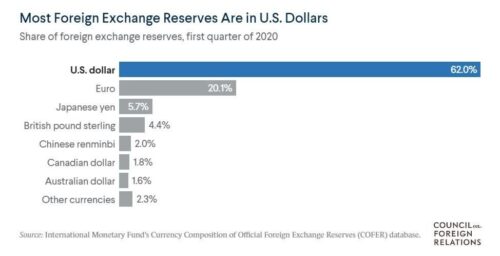
Source: Council on Foreign Relations
In an attempt to tame surging inflation, the Federal Reserve has engaged in the most aggressive tightening cycle in living memory. The higher interest rates go, the more demand there is for the dollar from foreign investors seeking greater yields on bonds and savings. The interest rate differential makes saving in the US more attractive relative to other countries, resulting in greater international capital inflows, increasing demand for USD and causing an appreciation in the currency by proxy. Furthermore, the USD is supported by investors seeking a financial safe haven in response to the economic instability that the world is facing given the war in Ukraine, rising inflation, and recent bank failures.
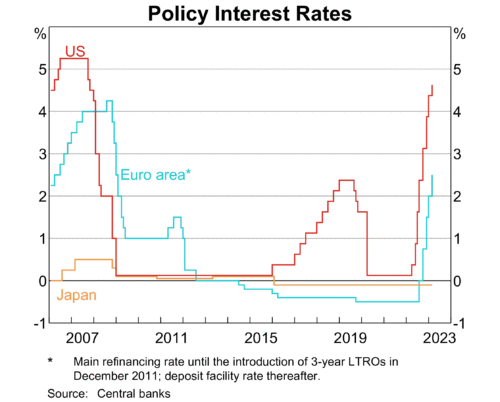
Source: Reserve Bank of Australia
However, the Fed’s tightening cycle is complicated by its expanding balance sheet. Its response to the collapse of SVB means that the Fed continues to lend more money, further increasing liquidity in the money supply. This is inflationary because it can lead to an increase in demand for credit, thus increasing the demand for goods and services, driving up prices. It risks signalling that the Fed is willing to tolerate structurally higher inflation to ensure financial stability (as the US market is over-leveraged after low COVID rates). Potential consequences of this include eroding the value of the USD and challenging the long-term value and stability of the currency, reducing the attractiveness of the USD as a reserve currency and pushing economies to look for alternative funding sources.
As the Congressional Budget Office forecasts greater government spending for the foreseeable future with no credible fiscal consolidation plan in sight, the United States’ financial position is buoyed by the USD reserve currency status. Since the USD is in perpetually high demand globally, the US government can borrow money at significantly lower interest rates than their counterparts, allowing them to borrow more. These days are quickly ending however, as rising interest rates are pushing interest payments to record highs.
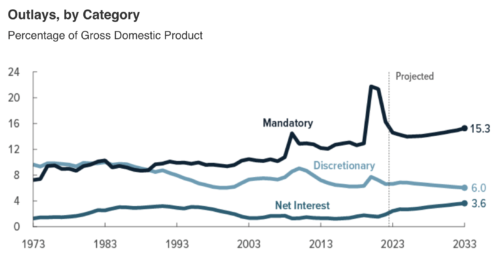
Source: Congressional Budget Office
This raises the question of how government spending will be reined in, with the divided congress at odds over spending cuts in response to the debt ceiling. Raising the debt ceiling is of crucial importance because it allows the government to finance existing debt obligations and continue borrowing, as the CBO projects deficit spending to continue. If fiscal policy inertia represents a threat to the ability for the US to service its obligations, it risks diminishing the status of the USD, shaking investor confidence and calling into question the stability of the world’s reserve currency.
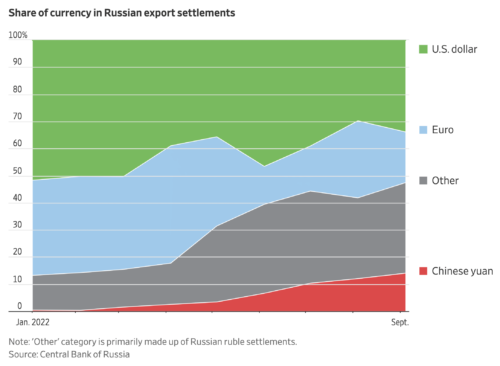
Source: Wall Street Journal
If the USD loses the faith of the global financial community, one naturally turns to its competing superpower, China, as the alternative reserve currency. The prevalence of the Chinese RMB (or Yuan) has grown along with China’s rising stature on the global stage.
Despite the sanctity of the United States Dollar as the “petrocurrency”, oil producing nations have become increasingly willing to accept the RMB as payment. Russia was the first domino, who, upon being all but shut out of global financial markets, turned to China not only as an ally, but a willing trading partner. Russia’s growing trade of oil to China has created a path for the RMB as a potential petro-currency.
Saudi Arabia, the world’s leading oil producer, is also now considering accepting RMB in the settlement of oil sales to China. Despite potential political motivations, long-term RMB-denominated oil sales would send shockwaves through currency markets.
Now, many question the importance of a transition to an RMB reserve currency from the existing regime. However, just as they differ vastly in ruling styles, the Chinese Communist Party (CCP) are far more interventionist in their management of currency. Firstly, the CCP currently “peg” the Chinese Yuan at lower levels. The People’s Bank of China sets the Yuan lower by buying significant USD reserves periodically, thereby “selling” Yuan for USD and reducing its value. Since the economic reforms of 2010, China’s currency remains shockingly rangebound. This behaviour fundamentally undermines their potential for use as a reserve currency in its current form.
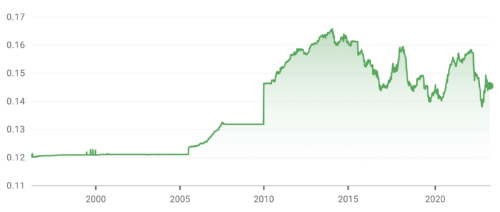
Source: Google Finance
While these currency manipulation tactics are not uncommon for individual countries (Singapore’s currency management is their monetary policy), it fundamentally subverts the nature of the global reserve currency. China cannot achieve the twin goals of maintaining RMB’s attractiveness to foreign markets and internationalising the currency, as if the RMB takes on the role of the reserve currency, it loses its export advantage. Moreover, a core part of a currency’s role as the global reserve is the confidence of financial markets in its stability. While monetary policy in the US is independent of politics, Chinese monetary policy is heavily influenced by the ruling CCP. This would likely make financial institutions wary of adopting the RMB as the reserve currency, due to their lack of confidence in the CCP as an appropriate steward of the global reserve currency.
Decentralised currencies are a type of currency with no central authority to control supply and value. For example, the properties of the US dollar are heavily influenced by the Federal Reserve through the use of monetary policy, minting, and other methods. This is not the case for decentralised currencies such as bitcoin. Bitcoin’s properties are driven instead by its community of users. This can be both beneficial and detrimental for its potential to become the reserve currency.
Bitcoin’s current volatility is a barrier that prevents it from becoming a reserve currency. This volatility stems from its illiquidity, meaning it is harder for it to be converted into cash, relative to other forms. This is in part due to the smaller number of participants in the market than that of the current reserve currency, the US Dollar, which by extension results in comparatively lower volumes of Bitcoin regularly traded. Daily transactions on the market for bitcoin hit just above 330’000 on April 3, 2023, whereas the volume for the USD on the Forex market was nearly 6 billion in January of the same year. This suggests that any singular trade large enough which occurs on the market could cause the value of bitcoin to massively fluctuate. This would be especially the case on the world stage where central banks would become power players in the market for decentralised currency. A dynamic like this promotes instability and uncertainty, which is detrimental to investor confidence and by extension, global economic growth.
However, the independence gained from a currency which isn’t regulated can certainly be considered an advantage. This is because it hypothetically limits the possibilities for central banks to manipulate the currency and thus project power onto each other. Today, the US Federal Reserve could certainly do something like this with its absolute control over the supply of the US dollar. An example of this would be restricting its supply to make it more expensive for countries to trade in Dollars. Manipulating a currency like Bitcoin on the supply side would not be possible since the supply is fixed, as per the supply limit imposed by creator, Satoshi Nakamoto. This promotes equity among the central banks of the world and reduces the amount of influence they have on each other. Nonetheless, the potential for this to happen is still prevented by its volatility. Any decentralised currency will have little-to-no chance of becoming the reserve currency if it cannot remain stable over time. It will fail in incentivising the reserve banks of countries worldwide to keep their currencies fixed relative to the new reserve currency.
The future of the reserve currency remains uncertain. Whilst the US dollar has succeeded in remaining the dominant global reserve currency despite changing economic conditions, the qualities of the alternatives could certify them as candidates to displace it. However, these candidates are not flawless either. Despite China’s growing presence on the international scene and its potential as a petro-currency, the possibility of an RMB reserve is hindered by China’s currency manipulation tactics and unstable political climate. And whilst it is enjoyable to speculate the prospects of bitcoin taking the title, its volatility prevents it from doing so.
References:
The CAINZ Digest is published by CAINZ, a student society affiliated with the Faculty of Business at the University of Melbourne. Opinions published are not necessarily those of the publishers, printers or editors. CAINZ and the University of Melbourne do not accept any responsibility for the accuracy of information contained in the publication.